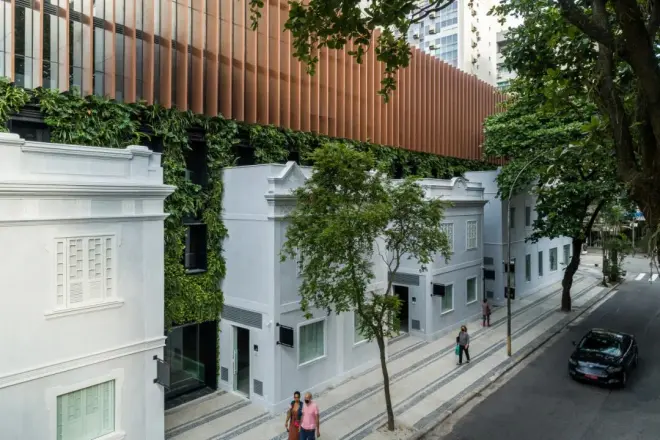Renewal-Zone:里约热内卢的大跨界︱一场围绕外立面的有旧有新

圣帕特里克学校曾是20世纪莱布隆社区最具记忆点的建筑之一,建筑师受邀将其打造为商业空间。
建筑立面作为一个保存完好的文化地标,成为了整个项目的核心元素。

为了推进建筑物的翻新,建筑师依据最新的土地使用法规,提议保留原学校原有外观,并打造一座全新的建筑。
更新修复涵盖对立面现状的深入研究,随后遵循原有的形态和建筑材料使用对原体量进行重新组合,同时加入必要的技术手段以确保新的部分与原有材料的兼容。

从立面开始,设计在一系列街区中构建了通往底层10家商店的通道和公共入口。上方的五层楼正被开发为具有高灵活度的办公空间,地下四层则用于停车。
场地位于莱布隆社区主街道的一角,在繁忙的交通和人流中拥有较高的识别度。

建筑师致力于通过垂直花园和木制挡板打造低调微妙的建筑风格,不破坏邻里对圣帕特里克原外墙的情感记忆。新建筑作为一个静谧的背景,彰显了旧建筑的空间韵律。
此外,挡板后的建筑进行了退界调整,以降低对周边的视觉影响,并在一定程度上重新诠释了周围建于20世纪50年代的建筑物的体量。


We have been given the responsibility of transforming the former Saint Patricks school, one of the strongest architectural memories of the 20th century in the Leblon neighborhood, into a commercial project.
The façade, a preserved cultural landmark, was the central element from which the entire project took shape.

In order to proceed with the renovation of the building, and based on the latest land use and occupation legislation, we proposed erecting a new building while preserving the original façade of the former school.
The restoration project involved an intense study of the pathologies, now in an advanced stage, of the façade and subsequent recomposition of the original volumetry, obeying the shape and the construction materials as well as the technical characteristics necessary for ensuring compatibility between the original materials and the intervention.

As of the façade, in a series of blocks, the passages and public accesses to the 10 stores on the ground floor were mapped out. Above, five floors are under development as office space with adaptable typologies, along with four underground levels for parking.
Positioned on one corner of the Leblon neighborhood's main avenues, the lot has high visibility in a location notable for heavy pedestrian and vehicle traffic.

We sought to adopt a subtle architectural style that, using vertical gardens and wooden baffles, did not impose itself on the neighborhood's emotional memory of the original Saint Patricks façade. The new building's Architecture acts as a silent backdrop that enhances the rhythms and volumes of the older one.
Added to this intention is the decision of rounding off and moving back the corners of the baffled volume, reducing the visual impact and to some extent reinterpreting the volumetry of the neighborhood's buildings, dating from the 1950s.



Location: Rio de Janeiro, RJ
Plot Area: 1.194,58 m²
Built Area: 5.140,13 m²
Architecture: Jacobsen Arquitetura
Architecture Team: Paulo Jacobsen, Bernardo Jacobsen, Edgar Murata, Marcelo Vessoni, Christian Rojas, Fernanda Maeda, Guilherme Pucci, Eduardo Aparício, Gustavo Borges, Thauan Miquelin
Interior Design: Jacobsen Arquitetura
Interior Design Team: Tatiana Kamogawa, Mariana Ferretti
Developer: Mozak
Photos: Pedro Mascaro
Awards:
Prix Versailles 2022 - Special prize for an exterior - Central America, the South and the Caribbean (casc).
· END ·

